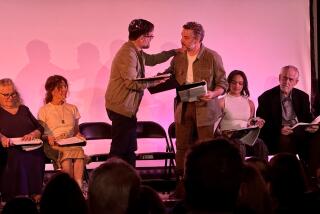Seeing ‘Twilight’ in a Different Light : Play Provides the Tools to Aid Understanding
For five months I worked with Anna Deavere Smith on her play “Twilight: Los Angeles, 1992,” secure in the understanding that we shared a common goal: to create a work of art that would reflect the racial and economic divisions that fed last year’s riots.
I was one of the dramaturges (literary consultants) brought into the company to help Smith sort through the material that would make up the script. Along with fellow dramaturges Elizabeth Alexander, Oskar Eustis and Dorinne Kondo, I met dozens of times with Smith as she worked to hone down transcripts from 170 interviews into a two-hour play. What emerged from our discussions was, I thought, a script that was a powerful social document, a moving theatrical portrait of a city in crisis.
*
You can imagine then my dismay when I read Jan Breslauer’s review of “Twilight.” Breslauer said that “Twilight” was “analytically shallow” and that it would only add to the racial divisions tearing the city apart, not heal them.
I couldn’t help feeling that Breslauer and I had seen different plays. To say, as Breslauer does, that “Twilight” presents the sort of analysis that “keeps groups apart” is absurd. In Smith’s solo performance, she takes the roles of 26 people and lets them have their say. They are affluent, poor and middle-class. They are Latino, black, Anglo and Asian. In effect, Smith has created the sort of citywide dialogue between ethnic and economic groups that rarely, if ever, exists in real life.
Overall, the effect of “Twilight’s” many voices is to depict a city whose residents feel trapped by the oppressive identities of race and class that Los Angeles offers them. Like ill-fitting clothes, we Angelenos are forced to wear the roles of “Anglo executive,” “Latino immigrant,” “Asian merchant” and “black gang member.” From working with Smith, I know that she searched for those moments in her interviews when her subjects felt the confining limits of these labels.
Both consciously and subconsciously, the characters in “Twilight” rebel against labels and stereotypes. An Anglo talent agent stutters and grapples for words as he tries to describe the guilt he felt during the riots; a Latino sculptor waves his arms in anger as he describes being beating by white police officers in the 1940s; a Korean merchant pounds her fist on a table as she describes her feelings about African-Americans and the civil rights movement. The result is a very human portrayal of the psychic wounds inflicted upon all of us by a society bitterly divided by race and class.
“Twilight’s” message is a subtle one, contained in the nuances of speech of 26 people, each very different from the others. The message is apparently too subtle for Breslauer, who wants political statements. Indeed, when Breslauer says that “Twilight” has failed to provide any political solutions to the city’s crisis, it’s clear that she’s missed the point.
The mission of “Twilight” is not to provide us with a manifesto, a platform, the political equation that, when solved, will equal justice. No work of art could do that, not in a city as complex and huge as Los Angeles. Instead, the idea is to give the audience the emotional tools they need to begin making their own solutions. To change the city, we must first feel and understand its sorrow. Anna Deavere Smith accomplishes this by using the voices of “Twilight” to break down the barriers that have kept us from listening to each other for too long.
More to Read
The biggest entertainment stories
Get our big stories about Hollywood, film, television, music, arts, culture and more right in your inbox as soon as they publish.
You may occasionally receive promotional content from the Los Angeles Times.











